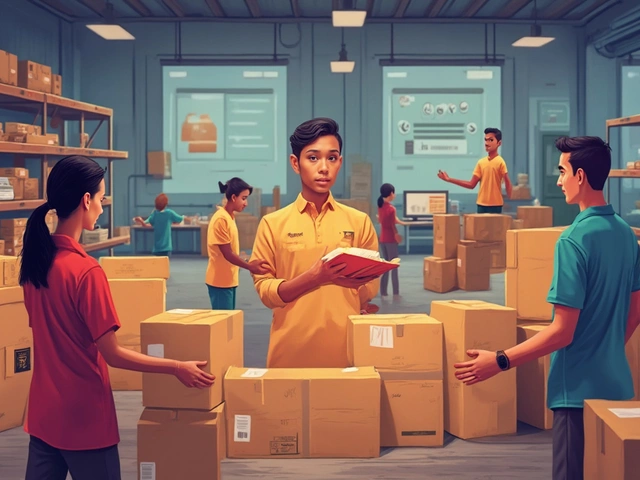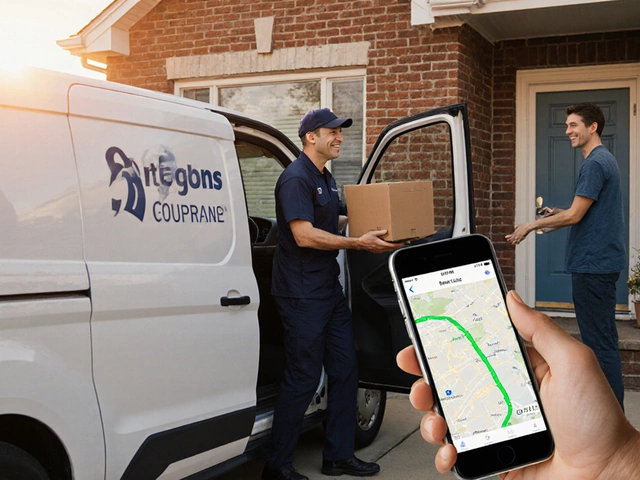Ever cracked open an online order and wondered how it made its way to your door so fast? Behind those seamless shipments is a game of Tetris that's happening in giant warehouses all over the world, powered by software most people never hear about. Choosing the best warehouse management system (WMS) is like picking the brain behind this orchestra—one that sorts products, predicts demand, and directs a ballet of forklifts, robots, and tired humans. It's tricky to cut through the flash and find a solution that actually keeps shelves stocked, orders accurate, and customers coming back. In the race for the best WMS, not all companies are created equal—some have slick dashboards but lack teeth in real use, others are so custom that setup costs could buy you a suburban duplex. Let's zero in on the real contenders and find out who's actually worth the hype this year.
The Heavyweights of Warehouse Management Systems
Start searching for the best WMS, and you’ll trip over names like SAP, Oracle, Manhattan Associates, Blue Yonder, and Infor. Each one claims to have cracked the code, but how do these systems really stack up in the trenches?
First thing: size matters. Enterprise-level solutions like SAP EWM and Oracle WMS are built for giants. Companies running hundreds of locations or with operations on different continents lean toward these platforms because of their global scale, crazy levels of configurability, and robust integrations with things like ERP, transportation systems, and even custom robotics. SAP EWM, for example, is known for its granular inventory tracking, labor management, and built-in analytics. It's the “German engineering” of warehouse software—complex, powerful, but sometimes more than most teams really need (and priced that way, too).
On the other hand, Manhattan Associates has a cult following for good reason. Their WMS is built for high velocity, real-time operations. It shines in retail and e-commerce settings, especially for companies juggling store fulfillment, returns, and tight shipping windows. What makes Manhattan stand out is its optimization algorithms: it doesn’t just show where stuff is, it actually suggests better picking paths, calculates labor needs, and anticipates bottlenecks. If you’ve ever ordered from a big-name apparel store and got your parcel shockingly fast, there’s a good chance Manhattan powered the back end.
Blue Yonder (formerly JDA Software) gets a lot of love for its AI capabilities. Their WMS uses machine learning to crunch forecasts, reroute orders on the fly, and help with tasks like replenishment and returns. It’s become a darling in grocery and fast-moving consumer goods—industries where tiny delays can make or break your bottom line. Meanwhile, Infor CloudSuite WMS is gaining steam with its cloud-first design. It appeals most to mid-sized businesses and distribution firms who can’t spend three years (and a small fortune) on implementation, but still want leading-edge tech and a friendly interface their staff won’t hate on Day One.
Let’s get real: even the best software won’t save a warehouse that has bad process, poor data, or miserable training. According to a 2024 Gartner report, nearly 43% of WMS projects that failed in North America blamed it on poor change management—not the software itself. So, while these heavyweight platforms flex muscle, the companies that win are the ones that match the tool to their true scale and culture.
| WMS Company | Key Strengths | Ideal Business Size | Notable Clients |
|---|---|---|---|
| SAP EWM | Deep configuration, global support, analytics | Large to enterprise | Siemens, Nestle |
| Oracle WMS | Flexible, integrates with ERP, strong reporting | Large | FedEx Supply Chain, Kroger |
| Manhattan | Speed, optimization, e-commerce savvy | Mid to large | Walmart, L'Oréal |
| Blue Yonder | AI-driven, real-time forecasting | Mid to large | Coca-Cola, Tesco |
| Infor CloudSuite | Cloud-native, usability, fast setup | Mid-sized | Adidas, Travis Perkins |
So which company really has the "best" WMS? There's no one-size-fits-all answer. For global pharma, SAP might be king. For midsize e-comm, Manhattan gets the crown. The smartest move is to match your real business headaches to the platform’s core strengths, not just the shiniest marketing.

What to Look For in a WMS (and What the Sales Decks Won’t Tell You)
You won’t get the full picture from a sales brochure. A good WMS isn’t just about features; it’s about how the system works in the messiness of everyday life. Here are the hidden levers that separate solid software from a six-figure regret:
- Implementation Timeline: SAP and Oracle can take up to 18 months to fully roll out, especially in multi-warehouse settings. Compare that to Infor or newer cloud WMS providers who can get a mid-sized operation online in just 2–3 months. Don’t just ask “how fast?”—ask about the people involved, training needs, and what kind of in-house expertise you’ll need to pull it off.
- User Experience: Nobody brags about learning warehouse systems, but the harsh truth is that if your team hates the screens, mistakes skyrocket. Manhattan and Infor score points for intuitive interfaces, drag-and-drop dashboards, and easy mobile use. A 2025 Forrester survey found that companies with process screens customized to their users saw 27% fewer data entry errors.
- Mobile and Robotics Integration: Robots, RFID, real-time scanning—they sound fancy, but only if the WMS doesn’t choke with third-party hardware. Blue Yonder has leapfrogged here, with built-in APIs for automation. SAP is catching up, but you’ll need deep IT talent to pull it off.
- Pricing and Licensing: Watch for per-user or per-location licensing. Enterprise WMS bills can balloon fast. Infor and some cloud-native solutions use “pay only for what you use” subscription models, which can be a big win for scalability—especially if you have seasonal spikes.
- Customizability vs. Out-of-the-box: Some companies need to handle multichannel returns, kitting, value-added services, or support temperature-controlled goods. Deeply customizable platforms like SAP or Oracle can fit any weird edge case… but that power comes with bigger bills and longer rollouts. If your business is more straightforward, you might be paying for complexity you don’t need.
- Support and Upgrades: System down at 3 a.m.? You’ll want support that actually answers. Cloud-native WMSs tend to have more streamlined, responsive support—especially for mid-sized firms who can’t afford internal IT armies.
Another thing most vendors won’t advertise: migration headaches. If you’re switching from a legacy WMS or even from paper (yes, some firms still do!), expect messy data, retraining, and “shadow IT” hacks from warehouse staff. Building in extra time for pilot programs or a phased rollout saves headaches later.
True story: My brother-in-law’s auto parts company switched to Oracle WMS last year. They had a gloriously detailed system… but nobody could actually use the picking module without three prompts and a cheat sheet. After three months, they rolled back to manual picking for fast-moving parts. The tech was great, but it didn’t fit the speed of their day-to-day needs. Lesson: demo the software with your real workflows, not just canned sample data. And bribing staff with pizza during training sessions doesn’t hurt either.

Tips for Choosing the Right WMS for Your Business
The world of WMS is more crowded than the Gardiner Expressway at rush hour. You’ll see plenty of bold claims, perfect dashboards, and “transformative” tech. But when you get past the jazz hands, the best warehouse management software is the one that matches your unique mix of order volume, inventory challenges, and team culture.
Here’s a practical roadmap for picking a winner without hating your life:
- Map Your Exact Workflows: Don’t just think about how things ‘should’ work—document how they really work on the floor. Include common exceptions, seasonal peaks, returns, and any handoffs to transport or production.
- Bring Floor Staff into the Conversation: The biggest disasters happen when the folks who actually receive, pick, and ship don’t get a say. They’ll spot friction points software engineers miss miles away.
- Insist on Live Demos with Real Data: Don’t fall for pretty mock-ups. Send the vendor sample item files, real receiving and shipping scenarios, even nastier edge cases like mispicks. See how the software reacts with messier data.
- Consider the Future (Not Just Today): If you have any shot at growing—whether it’s adding SKUs, channels, or satellite warehouses—pick a system that scales with you. Cloud models and modular WMSs make this easier.
- Check Integration with Existing Tools: Ask how the WMS talks to your current ERP, TMS, ecommerce platform, or even accounting software. Seamless APIs prevent “island” systems that just create new silos.
- Ask For Honest References: Don’t settle for cherry-picked case studies. Ask to chat directly with customers in a similar industry and size as yours. Most will be brutally honest about support, rollout snags, and what they’d do differently.
- Think About Total Cost of Ownership: Sticker price is one thing, but factor in implementation, training, support, upgrades, and license renewals. That “cheap” upstart solution could cost more in lost productivity if it crashes or doesn't scale.
For small companies or startups trying to break out of the spreadsheet cycle, cloud-based options like Fishbowl, Zoho Inventory, or 3PL Central offer a fast and affordable way to get real-time inventory, shipping, and returns under control. They might not come with every bell and whistle, but they’ll keep you from drowning in manual entry and chronic stockouts.
Finally, a fun fact: Walmart’s high-speed distribution centers (featuring Manhattan Associates’ WMS) can complete a complete order cycle—pick, pack, and ready for shipping—in under an hour for thousands of SKUs. Now, there’s power and speed, but also a reminder—there’s no secret sauce beyond matching the right technology to the right operation and building a team willing to adapt and learn.
Even as someone living in Toronto and seeing big operations running just down the 401, warehouses get more advanced each year—but no software upgrade can replace simple, clear processes and people who care about doing the job right. If something goes wrong, Luna, my dog, has a friend who chews cardboard boxes—a warehouse manager’s dream or nightmare? Technology is only as good as those who use it, after all.





